Argentina Daylight Saving Time (DST) Changes for 2007
Available Languages
Contents
Introduction
On December 21, 2007, the President of Argentina announced that daylight saving time (DST) will be observed beginning on December 30, 2007 and ending on March 16, 2008. No information was made available for future years' daylight saving time periods. This action was taken by Argentina to more efficiently use the limited electrical generation resources while new power generation capabilities are developed.
| Summary of Changes to Daylight Saving Time | ||
|---|---|---|
| Prior to 2007 | Year 2007 and After | |
| Start | DST not Observed | December 30, 2007 |
| End | DST not Observed | March 16, 2008 |
For more information, visit this URL:
http://www.lanacion.com.ar/973996-el-congreso-convirtio-en-ley-el-cambio-del-huso-horario ![]()
The configuration changes provided in this document are required to change the “programmed in” dates of daylight saving time for various time zones. Some devices that run newer software may not require this change if the enhancement request is included in the version of software that runs on the device. In software that includes this enhancement, the OLD summertime values have been changed to the NEW summertime values, and the configuration changes in this document are not required. For detailed information about individual products, see Affected Cisco Platforms.
Configuration or OS changes will need to occur on the devices that implement the old rules, so that the device time can be correct, in logs and other time stamped communications from the device/platform.
Prerequisites
Requirements
There are no specific requirements for this document.
Components Used
This document is not restricted to specific software and hardware versions.
Conventions
Refer to Cisco Technical Tips Conventions for more information on document conventions.
Scope and Impact
The DST change affects all devices that support an automatic time change when they are configured to support daylight saving time. This change impacts Cisco and non-Cisco devices. Customers should contact any vendor that uses time-sensitive messaging or other time-stamped communications in order to determine the impact of the change to beginning and end of daylight saving time.
Affected devices that are not changed could display the time exactly 1 hour off from the actual time during DST periods. In 2007, DST starts on December 30, 2007 and ends on March 16, 2008. This change takes effect for the first time in December of 2007. This change can have a major impact on event correlation activities that are performed as part of normal operations troubleshooting and monitoring.
For security-related devices, where logs are captured, correlated, and stored for future reference, this time change could render them incorrect for situations where they need to be recalled to rebuild a sequence of events. The incorrect timestamps might not be an issue for events that get immediate action. However, in the future, these events would reference incorrect times.
Any device with time-based controls and activities, such as a AAA (Authentication Authorization Accounting) servers, Content Devices (CEs), cron jobs, and video streaming servers can be impacted and should be checked with the appropriate vendor.
Other examples include calls being logged at the wrong times that could affect call detail reporting and billing information or inaccurate campaign dialing times that result in dialing customers outside allotted time periods defined by government agencies, which may be a violation of government regulations.
Consequently, any device with time-based controls and activities, such as authentication servers, synchronization activities, and scheduled events (that is, batch jobs, timed backups, or automated dialing capabilities or scripts for telemarketing purposes, etc.) would be impacted during the time period when the new Argentina DST rules go into effect.
Affected Cisco Platforms
The tables in this section list the Cisco enhancement IDs that were created in order to track the changes in the operating system defaults for various platforms. Versions of software that include these enhancements will correctly change the time when configured to observe daylight saving time. Software versions that do not include these enhancements, but support daylight saving time, will use the previous dates, which are invalid after December 30, 2007.
Refer to these categories for more information about your product:
In order to view each enhancement and the version in which it is integrated, click the appropriate Cisco Tracking ID or use the Bug Tool (registered customers only) . You must register with Cisco.com in order to view this information. For a full list of product Field Notices, refer to the Product Field Notice Summary page.
Application Networking Services
| Cisco Product | Cisco Tracking ID | Notes |
|---|---|---|
| Application and Content Networking System (ACNS) | N/A | See Application and Content Networking System (ACNS) in the Configurations and Workarounds section of this document for information about this product. |
| Content Services Switch (CSS) | N/A | See Content Services Switch (CSS) in the Configurations and Workarounds section of this document for information about this product. |
| Wide Area Application Services (WAAS) | N/A | |
| Wide Area File Services (WAFS) | N/A |
Interfaces and Modules
| Cisco Product | Cisco Tracking ID | Notes |
|---|---|---|
| Application Performance Assurance Network Module (NME-APA) | N/A | |
| Content Engine Network Module (NM-CE) | N/A | |
| Network Analysis Module (NM-NAM) | N/A | |
| Unity Express Network Module (NM-CUE) | CSCsm04830 | Refer to CSCsm04830—Hursley JVM-CUE, Argentina DST change on December 30 fails for information about this product. |
Cisco IOS Software
| Cisco Product | Cisco Tracking ID | Notes |
|---|---|---|
Cisco IOS® Solutions:
|
N/A | VPN 3K hardware should be manually changed through the GUI. Choose Configuration > System > General, and make changes in the Time and Date dialog box. VPN client applications should be changed through the Windows settings. VPN SPA should be changed with the clock command on Cisco IOS. See Cisco IOS Software Platforms in the Configurations and Workarounds section of this document for more information. |
| Cisco IOS Software Platforms | N/A | See Cisco IOS Software Platforms in the Configurations and Workarounds section of this document for information about this product. |
| Cisco IOS XR | N/A | See Cisco IOS XR in the Configurations and Workarounds section of this document for information about this product. |
Network Management
| Cisco Product | Cisco Tracking ID | Notes |
|---|---|---|
| Building Broadband Service Manager (BBSM) | N/A | |
| CiscoWorks | N/A | See CiscoWorks in the Configurations and Workarounds section of this document for information about this product. |
| CiscoWorks Common Services (CWCS) | N/A | |
| CiscoWorks LAN Management Solution (LMS) Version 2.2 | N/A | |
| CiscoWorks LAN Management Solution (LMS) Versions 2.5 and 2.6 | N/A | |
| CiscoWorks Network Compliance Manager (NCM) | N/A | |
| CiscoWorks Small Network Management Solution (SNMS) | N/A | |
| CiscoWorks Voice Manager (CWVM) | N/A | |
| Cisco Works Internetwork Performance Monitor (IPM) | N/A | |
| IP Solution Center (ISC) | N/A | |
| License Manager (CLM) | N/A | |
| Mobile Wireless Transport Manager (MWTM) | N/A | |
| NetFlow Collection Engine (NFC) | N/A | |
| Network Analysis Module (NAM) | N/A | |
| Network Connectivity Monitor | N/A | |
| Network Registrar (CNR) | N/A | |
| Performance Visibility Manager (PVM) | N/A | |
| QoS Policy Manager (QPM) | CSCsm02083 | Refer to CSCsm02083—Australian DST Changes/ Argentina DST Changes for information about this product. |
| Secure Access Control Server (ACS) | N/A | |
| Sheer 3.1, 3.2, 3.3, and 3.4 | N/A | |
| Signaling Gateway Manager (SGM) | N/A | |
| Subscriber Edge Services Manager (SESM) | N/A | |
| Transport Manager (CTM) | N/A | |
| WAN Manager (CWM) | N/A |
Optical Networking
| Cisco Product | Cisco Tracking ID | Notes |
|---|---|---|
| ONG Optical Products | N/A | |
| ONS 15000 Series Products | N/A | See ONS 15000 Series Products in the Configurations and Workarounds section of this document for information about this product. |
Routers and Switches
| Cisco Product | Cisco Tracking ID | Notes |
|---|---|---|
| CatOS Platforms | N/A | See CatOS Platforms in the Configurations and Workarounds section of this document for information about this product. |
Security and VPN
| Cisco Product | Cisco Tracking ID | Notes |
|---|---|---|
| Adaptive Security Appliances (ASA) Platforms | N/A | See Adaptive Security Appliances (ASA) and PIX Platforms in the Configurations and Workarounds section of this document for information about this product. |
| Adaptive Security Device Manager (ASDM) | N/A | |
| CiscoWorks Security Information Management Solution (SIMS) | CSCsm33357 | Refer to CSCsm33357—Need fix for Argentina and DST Change for information about this product. |
| DDOS Guard and Detector Appliance | N/A | |
| Incident Control Server (CICS) | EOS/EOL | Refer to the Cisco Incident Control System Products & Services page for more information about the status of this product. |
| Intrusion Detection and Prevention (IPS and Intrusion Detection System Service Module2 (IDSM2)) | N/A | See Intrusion Detection and Prevention (IPS and Intrusion Detection System Service Module2 (IDSM2)) in the Configurations and Workarounds section of this document for information about this product. |
| NAC Appliance (Cisco Clean Access) | N/A | |
| Secure ACS Appliance | N/A | |
| Security Agent (CSA) | N/A | Client operating system software must be updated. |
| Security Manager (CSM) | N/A | Cisco Security manager pulls time from the Server Operating System. Update the Windows Operating System to obtain the latest daylight saving time rules. CSM is supported on Windows 2000 Server and Windows 2003 Server. |
| Security Monitoring, Analysis and Response System (CS-MARS) | CSCsl01098 | Refer to CSCsl01098—To include patch for Venezuela & Argentina timezone change for information about this product. |
| Trust Agent (CTA) | N/A | |
| Video Surveillance Stream Manager (ICEVSSW) | N/A | |
| VPN 3000 Concentrators (Altiga OS) | EOS/EOL | This product is no longer being sold and might not be supported. Refer to the Cisco VPN 3000 Series Concentrators Products & Services page for more information about this product. See VPN 3000 Concentrators (Altiga OS) in the Configurations and Workarounds section of this document for workaround information. |
| VPN 3K Clients | N/A | VPN 3K hardware should be manually changed through the GUI. Choose Configuration > System > General, and make changes in the Time and Date dialog box. VPN client applications should be changed through the Windows settings. VPN SPA should be changed with the clock command on Cisco IOS. See Cisco IOS Software Platforms in the Configurations and Workarounds section of this document for more information. |
Storage Networking
| Cisco Product | Cisco Tracking ID | Notes |
|---|---|---|
| Storage Switches (SAN-OS) - Storage MDS 9500 Series | N/A | See Storage Switches (SAN-OS) - Storage MDS 9500 Series in the Configurations and Workarounds section of this document for information about this product. |
TelePresence
| Cisco Product | Cisco Tracking ID | Notes |
|---|---|---|
| TelePresence Codec | CSCsm92720 | Refer to CSCsm92720—Need to update with the new DST changes for Argentina for information about this product. |
| TelePresence Manager | N/A | TelePresence Manager versions 1.2 and earlier are affected. Upgrade to TelePresence Manager 1.3 or later to obtain the 2007 Argentina DST policy change definition. |
Tools and Resources
| Cisco Product | Cisco Tracking ID | Notes |
|---|---|---|
| Ciscoworks IP Telephony Monitor (ITM) Version 2.0 | N/A | |
| Unified Operations Manager (Cisco UOM) Versions 1.1 and 2.0 | N/A | |
| Unified Service Monitor (CUSM) Versions 1.1 and 2.0 | N/A |
Video, Cable, and Content Delivery
| Cisco Product | Cisco Tracking ID | Notes |
|---|---|---|
| Service Control Engine (SCE) | N/A |
Voice and Unified Communications
If you run a system of multiple Cisco Unified Communications products, please consult the appropriate System Upgrade Manual for recommended order in which to update products. There is a separate System Upgrade Manual for each version of Unified CallManager that a system is built around.
In order to locate information for system test releases based on Unified CallManager 4.x, System Upgrade Manuals, complete these steps:
-
Go to http://www.cisco.com/en/US/docs/voice_ip_comm/uc_system/GB_resources/ipcmtrix.htm.
-
Click the column heading appropriate to the release set that you use. (Note that the system test release version is not the same as the Unified CallManager version.)
-
Navigate to the link for the System Upgrade Manual.
Note: If you receive an error that states "Unable to open script," disable any anti-intrusion software or Cisco Security Agent that runs on the Cisco Callmanager before you run the DST patch.
In order to locate information for Unified Communications Systems based on Unified CallManager 5.x, System Upgrade Manuals, complete these steps:
-
Click the link that corresponds to the system release that you use. (The system release version is usually, but not necessarily, the same as the Unified CallManager version.)
-
Click the Prepare and Plan tab, and click the Planning Your System Upgrade link located in the Table of Contents on the left side of the page.
| Cisco Product | Cisco Tracking ID | Notes |
|---|---|---|
| Agent Desktop (CAD) | N/A | |
| Broadband Telephony Switch (BTS 10200) | N/A | |
| Collaboration Server (CCS) - 3.0, 4.0, and 5.0 | N/A | |
| Conference Connection (CCC) | N/A | |
| Contact Center Support Tools | N/A | |
| Email Interaction Manager | N/A | |
| Emergency Responder (CER) | N/A | |
| Fax Server | N/A | |
| Intelligent Contact Management (ICM) Enterprise - 4.x, 5.0, and 6.0 | N/A | |
| Interactive Suite (CIS) | N/A | |
| IP Communicator (CIPC) | CSCsm23748 | Refer to CSCsm23748—Change in Argentina DST affects CIPC in 2008 for information about this product. |
| IP Contact Center (IPCC) Enterprise | N/A | |
| IP Contact Center (IPCC) Express | N/A | |
| IP Contact Center (IPCC) Hosted - 4.x and 5.0 | N/A | |
| IP Interoperability and Collaboration System (IPICS) | N/A | IP Interoperability and Collaboration System (IPICS) will not provide an patch for the Argentina daylight saving time implementation at this time. |
| IP SoftPhone | N/A | Cisco IP Softphone is End of Sales. It is necessary to update the end user's Operating System to comply with the new daylight saving time rules in Australia. |
| Media Blender (CMB) 5.0 | N/A | |
| Outbound Option - 6.0, 7.0, and 7.1 | N/A | |
| Personal Assistant | N/A | Cisco Personal Assistant is End of Software Support and will not be updated for the daylight saving time change in Australia. |
| PSTN Gateway (PGW2200) | N/A | |
| Unified Application Environment (CUAE) | N/A | |
| Unified CallManager Backup and Restore System (BARS) | N/A | |
| Unified CallManager Express (CCME) | N/A | See Unified CallManager Express (CCME) in the Configurations and Workarounds section in this document. |
| Unified CallManager ITM | N/A | |
| Unified CallManager WinOS Service Release | CSCsl90908 | Refer to CSCsl90908—DST: MCS-OS update needed for 2007-2008 Argentina Summertime change for information about this product. |
| Unified Communications Manager (CUCM) Versions 3.x and 4.x | CSCsl90896 CSCsl90873 CSCsl90880 CSCsl90834 CSCsm03185 | Refer to these bugs for information about this product:
|
| Unified Communications Manager (CUCM) Versions 5.x and 6.x | CSCsl90896 CSCsl90834 CSCsl90890 | Refer to these bugs for information about this product: |
| Unified Communications Operating System (Linux) | CSCsl90904 | Refer to CSCsl90904—DST: UCOS update needed for 2007-2008 Argentina Summertime change for information about this product. |
| Unified Contact Center Enterprise/Hosted | N/A | |
| Unified Contact Center Express | CSCsl94239 | Refer to CSCsl94239—Unified CCX Considerations for 07/08 Argentina DST Changes for information about this product. |
| Unified Customer Voice Portal (CVP) | N/A | |
| Unified Intelligent Contact Management (ICM) ACD | N/A | |
| Unified Intelligent Contact Management Enterprise and Hosted - 7.0 and 7.1 | N/A | |
| Cisco Unified IP Phones: CP-3911 and CP-3951 | CSCsl93599 | Refer to CSCsl93599—DST: 3951/3911 update needed for 2007-2008 Argentina Summertime change for information about this product. |
| Unified IP Phones (7900 Series): CP-7906G, CP-7911G, CP-7931G CP-7941G, CP-7941G-GE, CP-7942G, CP-7945G CP-7961G, CP-7961G-GE, CP-7962G, CP-7965G CP-7970G, CP-7971G-GE | CSCsl90883 | Refer to CSCsl90883—DST: Phone update needed for 2007-2008 Argentina Summertime change for information about this product. |
| Unified MeetingPlace | CSCsl97394 CSCsl97402 | Refer to these bugs for information about this product: |
| Unified MeetingPlace Express | CSCsm23755 | Refer to CSCsm23755—Change in Argentina DST affects MPE in 2008 for information about this product. |
| Unified Personal Communicator (CUPC) | N/A | |
| Unified Presence (CUP) | CSCsl97553 CSCsl97556 CSCsl97560 CSCsl97565 | Refer to these bugs for information about these products: |
| Unified System Contact Center Enterprise (System IPCC) - 7.0, 7.1 | N/A | |
| Unified Video Advantage (CUVA) | N/A | |
| Unified Video Conferencing (CUVC) | CSCsm23761 | Refer to CSCsm23761—Change in Argentina DST affects CUVC Manager in 2008 for information about this product. |
| Unified Workforce Optimization (WFO) | N/A | |
| Unity Connection | N/A | |
| Unity Express (CUE) | CSCsm04830 | Refer to CSCsm04830—Hursley JVM-CUE, Argentina DST change on December 30 fails for information about this product. |
| Unity Voice Mail | CSCsm32824 | Refer to CSCsm32824—DST Argentina Unity: Update for Unity for information about this product. |
| VG248 Analog Phone Gateway | N/A | |
| Voice Provisioning Tool (VPT) | N/A | |
| Web Collaboration Option - 5.0 | N/A | |
| Web Interaction Manager | N/A |
Wireless
| Cisco Product | Cisco Tracking ID | Notes |
|---|---|---|
| Access Points and Wireless Controllers | N/A |
Configurations and Workarounds
This section contains workarounds or manual configurations for the more common Cisco platforms that support daylight saving time.
| Available Configurations | |
|---|---|
| Cisco Platform | Workaround Available |
| Adaptive Security Appliances (ASA) and PIX Platforms | Yes |
| Application and Content Networking System (ACNS) | Yes |
| CatOS Platforms | Yes |
| CiscoWorks | Patch |
| Content Services Switch (CSS) | Yes |
| Intrusion Detection and Prevention (IPS and Intrusion Detection System Service Module2 (IDSM2)) | Yes |
| Cisco IOS Software Platforms | Yes |
| Cisco IOS XR | Yes |
| Yes | |
| Storage Switches (SAN-OS)—Storage MDS 9500 Series | Yes |
| Unified CallManager Express (CCME) | Yes |
| VPN 3000 Concentrators (Altiga OS) | No—Set manually in March and November |
Adaptive Security Appliances (ASA) and PIX Platforms
You can change the DST configuration parameters for a system that runs the Cisco PIX or ASA OS with a single configuration command. You can run this command at any time and on any device in order to change the current default settings of the given device. Plug-in devices (ASDM, AIP-SSM, CSC-SSM, and other modules) to the ASA will take time from the ASA.
clock summer-time zone date month date year hh:mm month date year hh:mm [offset]
Note: If you do not use the summer-time option, you are not affected by this issue. To verify that you do not use the summer-time option, run this command: show run | include summer-time
If you do not receive output from this command, your device is not affected by this issue. If you receive output and your device is affected by this issue, contact the Cisco Technical Assistance Center (TAC) in order to obtain the 6.3(5.123) interim image.
Application and Content Networking System (ACNS)
You can change the DST configuration parameters for a Cisco Application and Content Networking System (ACNS) or Content Engine with a single configuration command. You can run this command at any time and on any device in order to change the current default settings of the given device.
clock summertime zone recurring [{week} {day} {month} {hh:mm} {week | day | month | hh:mm} [offset]]
In order to comply with the 2007 DST time change, use this command on any ACNS device:
clock summertime EDT recurring 2 Sun Mar 2:00 1 Sun Nov 2:00
CatOS Platforms
You can change the DST configuration parameters for a system that runs Cisco CatOS release 5.4 and later with a single configuration command. You can run this command at any time and on any device in order to change the current default settings of the given device.
set summertime date {month} {date} {year} {hh:mm}{month | date | year | hh:mm}[offset]
CiscoWorks
Management applications, such as CiscoWorks and Cisco Secure ACS, use the time provided by the operating system. Therefore, in order to resolve the DST issue, you must install the operating system patch that contains the fix for your operating system (Windows, Solaris, etc.).
If the platform includes an operating system that is maintained by Cisco, such as Unified CallManager or the ACS appliance, Cisco will provide a patch. See the affected products list in the Network Management section in order to determine when a patch will be available for your product.
Content Services Switch (CSS)
You can change the DST configuration parameters for a Content Services Switch (CSS) that runs WebNS with a single configuration command. You can run this command at any time in SuperUser mode on a CSS in order to change the current default settings of the given device.
clock summer-time zone date month date year hh:mm month date year hh:mm [offset]
Intrusion Detection and Prevention (IPS and Intrusion Detection System Service Module2 (IDSM2))
In order to change the summertime settings on Cisco Intrusion Detection and Prevention devices, use the setup option from the CLI:
Modify summer time settings? [no]:yes Recurring, Date or Disable[recurring]:date Start Month[mar]: Start Week[2]: Start Day[sun]: Start Time[02:00:00]: End Month[nov]: End Week[1]: End Day[sun]: End Time[02:00:00]: DST Zone[]: EDT Offset[60]:
Note: GUI-based management packages might include a time-based setup screen that you can use to make the necessary changes.
Cisco IOS Software Platforms
The Cisco IOS DST configuration parameters can be changed with a single configuration command. You may run this command at any time and on any device in order to change the current default settings of the device.
clock summer-time zone date month date year hh:mm month date year hh:mm [offset]
For detailed information about the clock summer-time command, refer to the Cisco IOS Network Management Command Reference.
Cisco IOS XR
You can change the DST configuration parameters for a system that runs Cisco IOS XR with a single configuration command. You can run this command at any time and on any device in order to change the current default settings of the given device.
clock summer-time zone date month date year hh:mm month date year hh:mm [offset]
ONS 15000 Series Products
Cisco has made changes to the ONS 15600, 15454, 15327, and 15310 products CTC and TL1 software so that the new DST implementation correctly changes with the new Argentina DST times.
Any systems that have not updated the system software will automatically follow the rules set for the previous daylight saving time. In other words, the system automatically modifies the clock and reflects the incorrect time because, on December 30, 2007, the system will not automatically presume that the DST has taken effect.
In order to comply with the 2007 DST time change, these options are available:
-
Obtain a new version of your software.
Cisco has implemented (or is implementing) the new DST changes into this software:
-
Release 4.1.82
-
Release 5.0.8
-
Release 7.0.2 or higher
-
Release 7.2.2 or higher
-
Release 8.0.x or higher
Other versions of this software will continue to operate with the previous DST rules.
-
-
Use CTC in order to manually change the time.
If customers do not want to upgrade to any of the above software releases. CTC provides you with the ability to enable or disable DST and also to change the time on your nodes. Customers must assume manual control over the system time and force the system clock to reflect the correct time.
In order to determine which days and times to manually change system time, see the Summary of Changes to Daylight Saving Time table in the Introduction section of this document.
-
Use the TL1 CLI in order to manually change the time.
You can change the time-of-day parameters for a system that runs the Optical Operating System (ONS) with a single configuration command. Here is the format of the command:
SET-TOD:[<TID>]::<CTAG>::<YEAR>,<MONTH>,<DAY>, <HOUR>,<MINUTE>,<SECOND>,[<DIFF>][:DST=<DST>];This command changes the time on an optical product that runs ONS. However, the daylight saving start and stop time will not change, and the product uses the defaults coded into the operational code.
If you do not fall into one of these listed categories, you should direct your inquires to your respective Account Manager.
Note: For more information on time zone configurations and how to reset the time, refer to the relevant procedure guide for the Cisco ONS release that you use. For example, if you use Cisco ONS 15454, refer to Cisco ONS 15454 Procedure Guide, Release 7.0.
Storage Switches (SAN-OS) - Storage MDS 9500 Series
By default, the MDS SAN-OS does not adjust for daylight saving time, and the software provides no default values for DST settings. Therefore, any configuration for daylight saving time must include the parameters for the start and end dates.
clock summer-time zone start_week start_day start_month start_time end_week end_day end_month end_time daylight_offset
Since the MDS SAN-OS offers no default values for the setting of summertime, no code changes are required. The DST setting for SAN-OS must be configured through the CLI for these reasons:
-
The Fabric Manager cannot be used to configure multiple switches with this setting as it does not support DST configuration.
-
Cisco Fabric Services does not support daylight saving time configuration as a single fabric can span multiple time zones.
Unified CallManager Express (CCME)
CCME uses Cisco IOS. Cisco IOS DST configuration parameters can be changed with a single configuration command. You can run this command at any time and on any device in order to change the current default settings of the device.
clock summer-time zone date month date year hh:mm month date year hh:mm [offset]
For detailed information about the clock summer-time command, refer to the Cisco IOS Network Management Command Reference.
VPN 3000 Concentrators (Altiga OS)
The DST Configuration parameters for a system that runs Altiga OS cannot be changed. Currently, in both the 4.1 and 4.7 releases of Altiga OS, you can enable the summertime feature in order to use daylight saving time default settings, as previously set. In order to work around this issue, you must set the time ahead one hour when the new daylight saving time occurs on the December 30, 2007. DST should be disabled on these devices so the device does not attempt to set ahead its clock on the March 16th.
Note: The information provided in this section is a workaround for those who choose not to upgrade to the fixed code once it is available.
You can disable daylight saving time and set the clock forward as shown in this image:
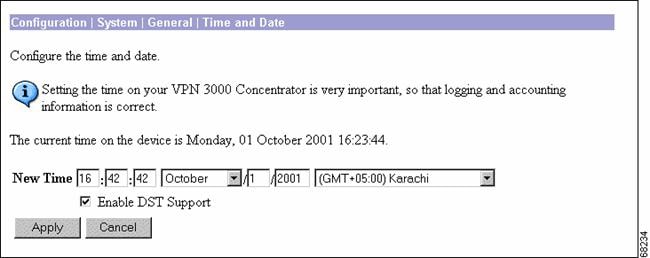
Windows Operating System
Use the Control Panel's Date and Time tool to change the Time Zone setting. Note that for Buenos Aires (Argentina), at GMT-03:00, there is no daylight saving time option.
-
Choose Settings > Control Panel from the Windows Start menu.
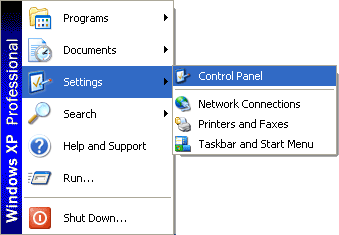
-
Double-click Date and Time.
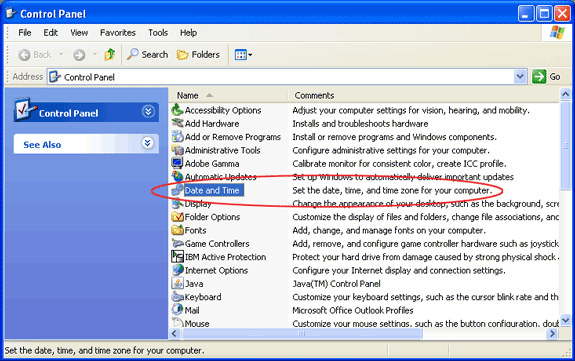
-
Change the time zone from (GMT-03:00) Buenos Aires, Georgetown to (GMT-03:00) Brasilia.
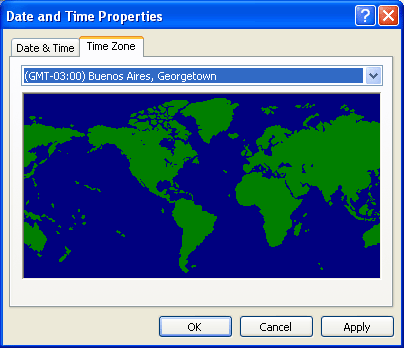
-
Check the Automatically adjust clock for daylight saving changes check box in order to add one hour to the system time.
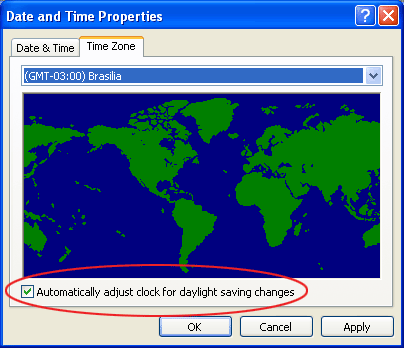
Note: The Brasilia (Brazil) option is also GMT-03:00, but (unlike Buenos Aires) this option displays the option to automatically adjust the clock for daylight saving changes.
Document ID: 100508




 Feedback
Feedback